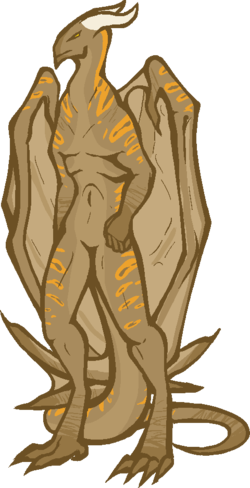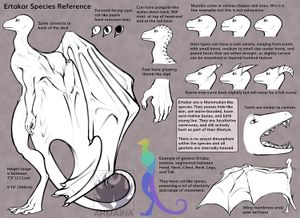Ertakar
From Arma Wiki

| |
|---|---|
| Information |
Ertakar(air-tah-kar) Are the dominant species and native, sentient inhabitants of the planet Sytous. Due to their similarities to Human-associated dragons, they often get referred to as Dragons or Drakes. More insulting labels provided by Humans will regard them as reptile or lizards despite them not having many biological similarities to reptiles.
Contents
Physiology
Ertakar are classified as a mammalian species, despite appearing similar to upright standing draconic creatures. They are warm blooded, with a body temperature of 32℃ (89.6℉) and a semi-hollow bone structure reminiscent of earth dinosaurs. To accommodate their wings, they have a second set of scapula and pectorals. Due to a form of floating furcula, their arms can be both at their sides as well as in front of them, similar to an earth bear, allowing their wings the space needed for downward flaps and lifts. Their torso and spines have greater elasticity, similar to earth cats, allowing them to achieve both bipedal and quadrupedal movement with natural ease. Potential height of the species comes at around 7ft to 9ft.
Appearance
Skin on an Ertakar is a type of thick hide, with certain strains that may produce a type of plated scaling down the back. Those of patchier/plated skin can be traced back more rugged terrain and arid environments, those of smoother skin can be traced to more temperate and humid environments. Colors can range from earthy tones of brown and yellow, cool tones of blue and green, warm tones of red and orange, or simple colors of black, white and gray.Along with varying skin types and color patterns, Ertakar are made most unique by the set of horn and bone arrangements on their skulls, or even lack of. While likely originally adapted for protection, in current society it is more used as a means of display, for attraction or intimidation. Arrangements range from short and long horns, grouped and solitary, along with other protruding bone structures.
Diet
Ertakar are facultative carnivore; carnivores with some exceptions for plant matter. As such their diets consist largely of many manner of prey animals, with some incorporation of fruits, vegetables, and gourds for taste and variety. They have difficulty digesting plan matter with a high volume of cellulose such as leafy plants and are lactose intolerant.
The majority of the Ertkar diet is unprocessed and often uncooked entirely, preferring to eat raw fresh kills. Ertakar still actively hunt for their meals, both as a solitary activity and sometimes a social one, though butcheries exist not only for human ease of access but conveniences for busy or disabled Ertakar, unable to easily hunt on their own. The process of cooking is one used primarily used for preservation and storage, as well as novelty.
Sex and Reproduction
There is no sexual dimorphism within the species, in addition, the genitalia of the Ertakar are all internally housed, making them nearly unnoticeable when standing upright.
Ertakar are polyoestrous and ovulate via induced ovulation. Erakar birth their young live, with a gestation period of about 13 months, after giving birth they do not enter an oestrus cycle again until 5-8 years after the birth. Unlike earth-classified mammals, the species does not have any mammary glands, due to the long gestation period, young are able to digest foods that have been prepared. Traditionally this would be by way of pre-chewed foods similar to crop milk, but more modern methods incorporate food processors for ease of use.
Society
Gender
Most societies on Sytous do not have a concept of 'gender roles'. Apart from a few separated cultural groups, the majority of the society has very little split in presentation, careers or lifestyles within the species. The majority of their own languages do not even have gendered pronouns.
Romance and Relationships
For the majority of Ertakar, long term coupling is unusual. Most Ertakar have 2 or 3 long term relationships in their lifetime, usually correlating with the length of time it takes to raise young. There does not seem to be any significant difference in relationship length between Ertakar couples that choose to bear children and those that do not.
Post War Culture
After the end to the war and the merge of a new culture into their own, the shape of their entertainment, fashion and other elements of the arts, changed the most dramatically.
Religion
Wardens of Life
One of the most prominent, ancient religions of Ertakar society, are the 'Wardens of Life'. They live in small numbers around the 'Cradle of Life', an extremely lush crater in a temperate hemisphere. The land itself is considered a reservation, leaving it untouched by modern change, which has ultimately lead to it's survival.
History
Ertakar Human War
The main turning point in the Ertakar's basic life style, was the war between the Ertkar and Humans. While Humans had visited the Planet looking for new places to colonize, an unknown act of violence during one of the meetings with the large clan closest to the landing caused a war to break out between the Ertakar and Humans.
In hopes of gaining an advantage in the war, the Erta's best geneticist worked on manipulating the genes of their own soldiers to make them look like Humans. Of course, the risks involved were drastic, and lives were lost in a processes that took over a year. The final product, was Erta that could transform into a human form. Of course, the final human form had it's flaws, often times, discolored skin, or lack of hair, but such things could be masked easily.
Though this new ability helped them infiltrate enemy ranks and give them a bit more of an edge in the battle, eventually this advantage did not help enough in the long run as the Erta and their lack of militant experience on this scale was turning the war into a loosing battle for them.
In a drastic effort to turn the tides of the war, the used their skills to splice captive Human soldiers and threaten to take the genetic splicing on a larger scale, in hopes the act would cause the Humans to react. The Humans saw the act as barbaric and the desire to end the war came about quickly.
A treaty was formed between the two to put an end to the war.
Currently, Hundreds of years after the initial war, the Humans and Ertakar now coexist, both on Sytous and Earth, however the effects of the war are still apparent in the culture of each civilization.
| Species | |||
| Sytous | Ertakar • Teotkoa • Jal-Kar • Human | ||
|---|---|---|---|
| Ehga | Keemex • Bird | ||
| Taia | Taithal | ||
